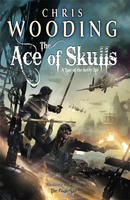 The Ace of Skulls concludes the saga of the Ketty Jay. In the previous three books we have followed captain Darian Frey through a series of disastrous adventures which he has sometimes just barely managed to survive. These trials have also forged a real crew out of the strange collection of people who have ended up on his airship Ketty Jay. And sometimes they have even made some profit from their adventures.
The Ace of Skulls concludes the saga of the Ketty Jay. In the previous three books we have followed captain Darian Frey through a series of disastrous adventures which he has sometimes just barely managed to survive. These trials have also forged a real crew out of the strange collection of people who have ended up on his airship Ketty Jay. And sometimes they have even made some profit from their adventures.
This time the deepest weakness of Darian Frey leads him to risk everything, including his friends.
The best thing about this series is the character development. Noone is really easily likeable when we first meet them, but all of the people on board the Ketty Jay together manage to transcend their weaknesses and do some really great things. Individually they continue to often be annoying or silly or even repelling, in a very human way.
The world building is also interesting: a planet with varying landscapes and climates, and populated by many different nations and groups. This planet has an ancient history, much of it lost in a mythological haze, with lost civilisations and strange forgotten artefacts. There is also magic: a very scientific looking kind of magic based on capturing and binding daemons. Daemonism has been outlawed in Vardia (the nation most of the crew comes from), because of the dangers involved, but of course it is practised anyway.
You sometimes hear people describe the Ketty Jay books as similar to the TV series Firefly. The works have some things in common: an odd combination of people on a kind of ship, making a living on the shady side of things. Some of them with dark secrets. Still, I don't think that Firefly and the Ketty Jay stories are that similar at a closer look.
And there is no metal golem on Serenity.
To another question: is it steampunk?
Some people want steampunk to be only about alternate history, preferably set in London. At the same time there is so much being published (and read) as steampunk that does not fit this description that it's useless as a definition of steampunk.
What Chris Wooding has written here is clearly fantasy, set in a secondary world. But it has airships, and lots of strange and fancy machinery with gleaming brass parts. Some of the technology seems fairly advanced, but the society in Vardia is almost feudal and we don't get to see much that looks like industrialization. Call it what you want, but the label steampunk can be wide enough to encompass these books.
But labels may not be that important. These books give us well written, fast paced adventures, and sometimes that is just exactly what you want.


 Follow us on Twitter
Follow us on Twitter Follow our Instagram
Follow our Instagram Our videos on YouTube
Our videos on YouTube

